Industrial Safety Nets

Industrial Safety Nets
Industrial Safety Nets Are Critical Safety Measures Used In Industrial Settings To Prevent, Protect Workers, And Safeguard Equipment. These Nets, Also Known As Construction Safety Nets Or Protection Nets, Are Designed To Mitigate The Risks Associated With Working At Heights, Such As Construction Sites, Warehouses, Factories, And Other Industrial Environments.
The primary purpose of industrial safety nets is prevention. Working at heights poses significant hazards, including the risk, which can result in severe or fatalities. Industrial safety nets act as passive protection systems, providing a reliable means of catching workers or objects that from elevated work areas, scaffolding, or platforms.
Why Choose Us?
- Expertise and Experience
- Professional Installation
- Affordable Pricing
- High-Quality Materials
- Customized Solutions
- Excellent Customer Service
Industrial Safety Nets Offer Comprehensive Protection For Workers, Equipment, And Bystanders, Enhancing Safety In Industrial Settings. By Installing Safety Nets Around Elevated Work Areas Or Perimeter Edges, Employers Demonstrate A Commitment To Prioritizing The Well-Being Of Their Workforce And Minimizing The Potential For Incidents.
Moreover, industrial safety nets are versatile and adaptable to various industrial applications and environments. They can be customized to fit specific site requirements, whether for temporary or permanent installations, and are available in different sizes, configurations, and load capacities to suit different needs.
Installation of industrial safety nets requires careful planning and adherence to safety standards and regulations. Proper installation, maintenance, and inspection are essential to ensure the effectiveness and reliability of safety nets in preventing and protecting workers and assets in industrial settings.
Overall, industrial safety nets are indispensable safety investments for industries where working at heights is common. By providing reliable protection, these nets help mitigate risks, promote a safer work environment, and ensure the well-being of workers and equipment in industrial facilities.
Frequently Asked Questions
- What are industrial safety nets, and why are they important?
Industrial safety nets are robust protective barriers designed to prevent falls and accidents in industrial environments such as construction sites, warehouses, and factories. They are essential for ensuring the safety of workers by providing a secure safety measure, reducing the risk.
- What materials are used in industrial safety nets?
Industrial safety nets are made from high-strength, durable materials such as nylon or polypropylene. These materials are resistant to wear, tear, and harsh weather conditions, ensuring long-lasting protection in demanding industrial environments.
- How are industrial safety nets installed?
Professional technicians install industrial safety nets by carefully assessing the specific needs of the site and customizing the net to fit perfectly. The installation process involves securely attaching the net to appropriate structures, ensuring it can effectively catch objects or personnel and prevent.
- Can industrial safety nets be customized for different applications?
Yes, industrial safety nets can be customized to suit various applications and environments. Whether for construction sites, warehouses, or manufacturing facilities, these nets can be tailored in size, shape, and strength to meet the specific safety requirements of different industrial settings.
- How do I maintain and inspect industrial safety nets?
Industrial safety nets require regular inspections and maintenance to ensure they remain in good condition. They should be checked for signs of wear, damage, or deterioration and cleaned as needed with appropriate solutions. Any damaged sections should be repaired or replaced promptly to maintain the net's effectiveness.

